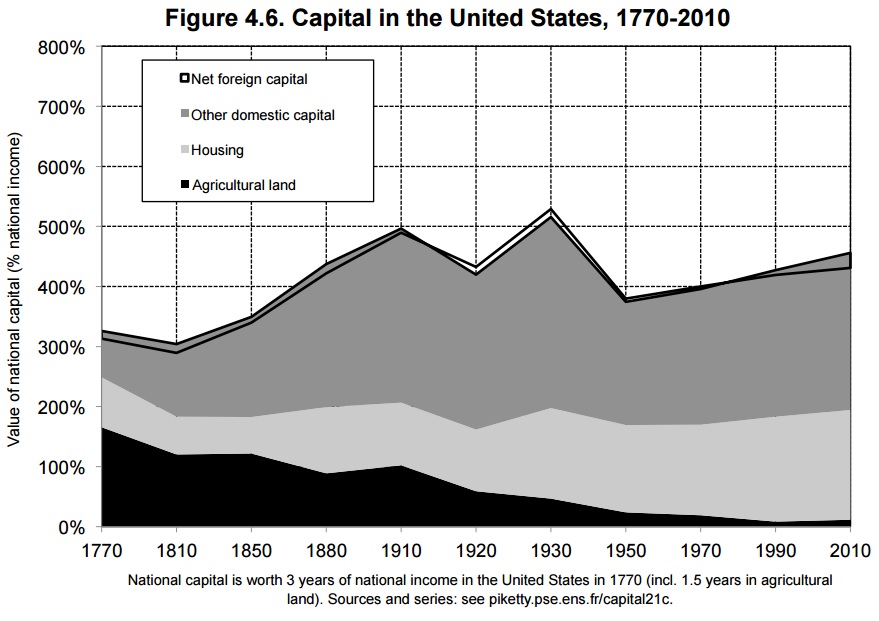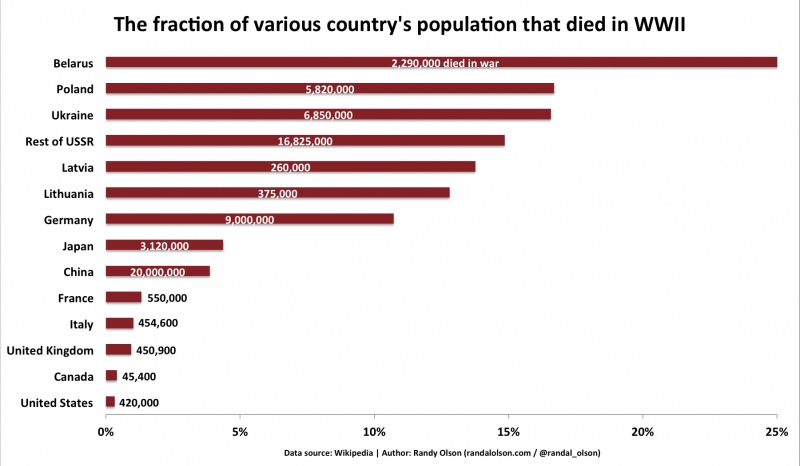Chapter is titled “From Old Europe to the New World.” It covers the same ground as chapter 3, but looks at major economies other than those of Britain and France. The first part focused on Germany, which then led to discussion of the collapse of European Capital/Income ratios due to the World Wars.
Part two looks at the United States, Canada, and touches on Net Foreign Capital.

Thomas Piketty points out two things here. One is that the Capital/Income ratio c. 1800 is far smaller in the United States than in Europe: around 3 rather than 6 or 7. — and that much of this difference is explained by the smaller value of agricultural land (around 1x annual income in the United States vs. at least 3x annual income in Britain and France.) An irony here is the land was so abundant in the United States compared to the Old World that it was dirt cheap, suggesting that real price and value are two different things.
(In economics, we call this the diamond-water paradox, that something of extremely low value to society can be so highly priced while something essential for life itself can be extremely cheap.)
Thomas Piketty adds that housing and business capital also were lower. In short, immigrants did not arrive with houses or often even large tools, and it took time to build these up.
The other major difference is that the Capital/Income ratio has been much more stable than it was in Europe. In Britain and France it stated the 20th Century at 7, fell to under 3, then climbed back up to over 6 Meanwhile, in the United States it started around 5, fell to around 3.8, and climbed back up to a bit above 4. Quite simply, our country was far less affected by the World Wars, measured as either economic impact of % of the population killed.

Note that 5 of the top 6 countries (Belarus, Ukraine, Latvia, Lithuania, “Rest of the USSR”), were all part of the USSR during the decades around World War Two.
Things would change over the course of the nineteenth century. The share of agriculture in output decreased steadily, and the value of farmland also declined, as in Europe. But the United States accumulated a considerable stock of real estate and industrial capital, so that national capital was close to five years of national income (compared to 7 in Western Europe). This gap with Europe remained, but it had shrunk by half in one century. The United States had become capitalist, but wealth continued to have less influence than in the Bell Epoque ( = pre-WW1) Europe, at least if we consider the vast U.S. territory as a whole. If we limit our gaze to the East Coast, the gap is smaller still. In the film Titanic, the director, James Cameron, depicted the social structure of 1912.
In other words, the East Coast, which had been settled longest, had developed the most inequality, while the newly-settled West, where the Homestead Act had given free land to family farmers, had the least. Sadly Thomas Piketty doesn’t go into too much detail here, but this is another illustration of the basic thesis of the book: that wealth is an unstable equilibrium, where differences in wealth magnify.

Thomas Piketty looks at the 20th Century, and points out some differences between the United States and Europe. Direct physical destruction from the World Wars, a significant if not majority cause of the call of the capital/income ratio in Europe, was negligible in the United States. During World War One the United States entered the war much later (Significant numbers of American soldiers got into combat only during the last six months of the 4-year war.)
 The ‘U-Shaped Curve’ of the capital/income ratio in the twentieth century is smaller in amplitude in the United States than in Europe. Capital in the United States seems to have achieved virtual stability—so much so that a stable capital/income or capital/output ratio is sometimes treated as a universal law in U.S. (economics) textbooks (like Paul Samuelson’s). (This more stable capital/income ratio) perhaps explains why Americans seem to take a more benign view of capitalism than Europeans. (Page 154-155)
The ‘U-Shaped Curve’ of the capital/income ratio in the twentieth century is smaller in amplitude in the United States than in Europe. Capital in the United States seems to have achieved virtual stability—so much so that a stable capital/income or capital/output ratio is sometimes treated as a universal law in U.S. (economics) textbooks (like Paul Samuelson’s). (This more stable capital/income ratio) perhaps explains why Americans seem to take a more benign view of capitalism than Europeans. (Page 154-155)
Following this is a bit about “net foreign capital.” For the United States Net Foreign Capital = (Capital in other countries by American citizens) – (Capital in the U.S. owned by foreigners). Substitute any country for the United States.
Another key difference between the history of capital in American and Europe is that foreign capital never had more than a relatively limited importance to the United States. This is because the United States, , the first colonized territory to achieve independence, never became a colonial power itself. (page 155).
For most of the nineteeth century, net foreign capital in the United States hovered around negative 10% of income,. (while for England it was up to positive 200% of income!), which represented under 3% of capital ownership. Of course, foreign ownership was higher than 3%, as Americans had foreign investments as well, but overall this was small. Overall, American investments were less than 5% of European foreign investment portfolios. “To sum up, the world of 1913 was one in which Europe owned a large part of Africa, Asia, and Latin America, while the United States owned itself.” (page 155)
World War 1, in which Britain and France borrowed heavily from the United States (which held them to every frank and pound of debt, at the same time that German debts were repudiated), turned this position slightly positive. It fell into the negatives again in the 1980s, but in all cases, the position was fairly small. By today, it represents about negative 20% of national income. To put it another way, on net close to 5% of American capital is foreign-owned, while the other 95% remains American-owned.

Thomas Piketty then adds Canada as almost a footnote, observing that foreign (mainly British) ownership of Canadian capital was far higher than it was for the Untied States: in 1910, net foreign capital was around -120% of annual income, or between 20% and 25% of Canadian capital was foreign owned! As with the United States, the wars of the 20th Century changed this, turning net capital from a large negative to a small negative.
The comparison of the United States with Canada is interesting, because it is difficult to find purely economic reasons why these two North American trajectories should differ so profoundly. Clearly political factors played a central role. Although the United States has always been open to foreign investment, it is fairly difficult to imagine that nineteenth-century US citizens would have tolerated a situation in which one-quarter of the country was owned by its former colonizer. This posed less of a problem in Canada, which remained a British colony….Similarly, the fact that Canada’s net foreign assets remained negative for so long is linked ot the absence of any violent political rupture (Canada gradually gained independence from Britain, but its head of state remains the British monarch.) and hence to the absence of expropriations of the kind that elsewhere in the world generally accompanied access to independence, especially in regard to natural resources. (page 158)

Queen Elizabeth II inspects a Guard of Honour outside the Canadian Parliament, after arriving to attend the Canada Day celebrations, in Ottawa, Canada.
In other words, when a foreign government is overthrown violently, foreign-owned property typically is seized without compensation. This didn’t happen in Canada.